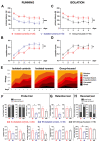Voluntary Wheel Running in Old C57BL/6 Mice Reduces Age-Related Inflammation in the Colon but Not in the Brain
- PMID: 35159375
- PMCID: PMC8834481
- DOI: 10.3390/cells11030566
Voluntary Wheel Running in Old C57BL/6 Mice Reduces Age-Related Inflammation in the Colon but Not in the Brain
Abstract
Inflammation is considered a possible cause of cognitive decline during aging. This study investigates the influence of physical activity and social isolation in old mice on their cognitive functions and inflammation. The Barnes maze task was performed to assess spatial learning and memory in 3, 9, 15, 24, and 28 months old male C57BL/6 mice as well as following voluntary wheel running (VWR) and social isolation (SI) in 20 months old mice. Inflammatory gene expression was analyzed in hippocampal and colonic samples by qPCR. Cognitive decline occurs in mice between 15 and 24 months of age. VWR improved cognitive functions while SI had negative effects. Expression of inflammatory markers changed during aging in the hippocampus (Il1a/Il6/S100b/Iba1/Adgre1/Cd68/Itgam) and colon (Tnf/Il6/Il1ra/P2rx7). VWR attenuates inflammaging specifically in the colon (Ifng/Il10/Ccl2/S100b/Iba1), while SI regulates intestinal Il1b and Gfap. Inflammatory markers in the hippocampus were not altered following VWR and SI. The main finding of our study is that both the hippocampus and colon exhibit an increase in inflammatory markers during aging, and that voluntary wheel running in old age exclusively attenuates intestinal inflammation. Based on the existence of the gut-brain axis, our results extend therapeutic approaches preserving cognitive functions in the elderly to the colon.
Keywords: Barnes maze; aging; gut-brain axis; hippocampus; inflammaging; intestine; physical activity; social isolation; spatial learning.
Conflict of interest statement
The authors declare no conflict of interest.
Figures



References
-
- GBD 2017 Disease and Injury Incidence and Prevalence Collaborators Global, regional, and national incidence, prevalence, and years lived with disability for 354 diseases and injuries for 195 countries and territories, 1990–2017: A systematic analysis for the Global Burden of Disease Study 2017. Lancet. 2018;392:1789–1858. doi: 10.1016/S0140-6736(18)32279-7. - DOI - PMC - PubMed
Publication types
MeSH terms
LinkOut - more resources
Full Text Sources
Medical
Research Materials
Miscellaneous

